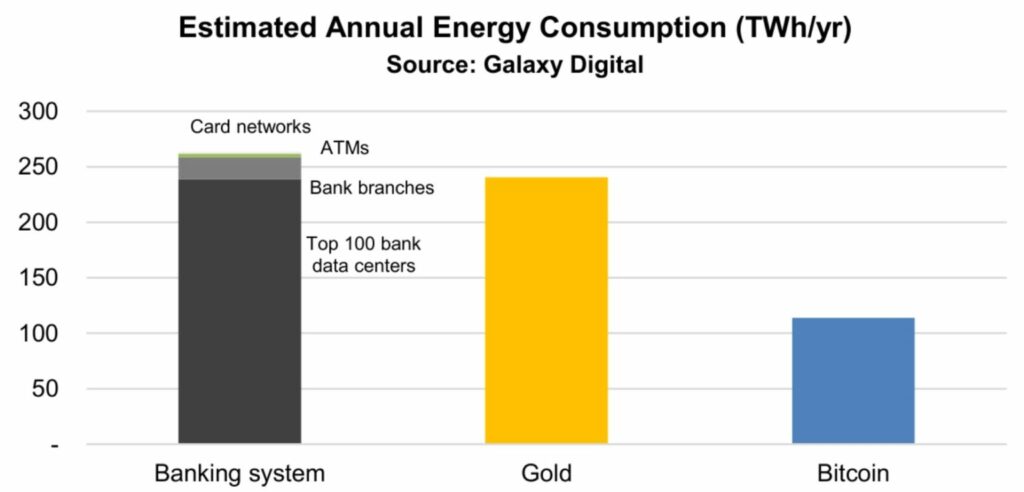Cryptocurrencies, particularly Bitcoin, have long been in the spotlight for their energy consumption and perceived environmental impact. Critics have often raised concerns about the substantial energy usage of cryptocurrency networks, especially when it comes to the sources of this energy. However, a closer examination reveals that the situation might not be as dire as it’s often portrayed.
Studies have shown that a significant portion of the Bitcoin mining network relies on renewable energy sources like solar, wind, and hydropower. Despite this, the energy debate continues to swirl around cryptocurrencies. In this article, we’ll delve into the dynamics of how Bitcoin consumes energy, compare its energy footprint with that of the central banking system, and explore emerging technologies that are making crypto more sustainable.
One of the main criticisms of cryptocurrencies (especially Bitcoin) is the amount of energy they use, and the type of energy they use (whether the energy is produced by fossil fuels or clean energy sources like wind, solar, etc.). However, the energy problem may not be as bad as people make it out to be.
A research study by CoinShares found that approximately 74.1% of the Bitcoin mining network gets its electricity from renewable energy sources like solar, wind, and hydropower. So why do people use this subject to attack crypto as a whole, and what can be done about it? First, we need to understand how Bitcoin uses energy and how its energy consumption compares to the central banking system. Then, we’ll look at a new technology that’s helping reduce crypto’s environmental footprint.
How Does Bitcoin Use Energy?
The Bitcoin network functions using a Proof-of-work (PoW) system, meaning that the algorithm the network is based on needs miners to validate transactions. Miners vary greatly in size and computing power; but typical large-size operations are warehouses full of computers that constantly run, trying to solve the next block to gain a reward. Additionally, as time progresses, the blocks are increasingly difficult to solve, meaning that mining operators need to add computing power, which uses more energy.
Bitcoin also requires energy to store data and information.
How Much Energy Does Bitcoin Use?
According to the Cambridge Bitcoin Electricity Consumption Index, Bitcoin is on track to use approximately 89.1 Terawatt hours (TWh) of electricity in 2022. To put this figure into perspective, Bitcoin is estimated to use about 0.05% of global energy and produces about 0.08% of global carbon emissions, according to CoinShares.
How Does Bitcoin Compare To The Central Banking System?
Blockchain and digital asset trading company Galaxy Digital published a report in 2021 calculating the estimated energy usage of the global banking system, the gold industry, and Bitcoin.

As illustrated in the graph, Bitcoin uses far less total energy in terms of Terawatt Hours in comparison to the global banking system and the gold industry.
The central banking system, which includes ATMs, card networks, bank branches, and bank data centers, operates differently from cryptocurrencies in terms of energy consumption and sustainability efforts. Here’s a detailed comparison of these two systems:
How Does Crypto’s Energy Consumption Compare to Centralized Banking’s Energy Consumption?
Cryptocurrencies, particularly those using Proof of Work (PoW) consensus algorithms like Bitcoin, can be energy-intensive. The process of mining, which involves solving complex mathematical problems to validate transactions and secure the network, consumes a significant amount of electricity. This has led to concerns about the carbon footprint of cryptocurrencies like Bitcoin. It is important to know that sustainability and energy efficiency efforts are in motion and growing year by year. New consensus algorithms, energy-efficient storage solutions, and innovations in technological resources have paved the way for a smaller carbon footprint.
The central banking system, which includes physical bank branches and ATMs, does consume energy as bank branches and ATMs primarily require electricity for lighting, heating or cooling, and powering ATM machines. As the graphic above shows, the large scale consumption is much larger than crypto’s.
What Kinds Of Sustainability Efforts Does Cryptocurrency Partake In?
The cryptocurrency community has been actively exploring ways to reduce its environmental impact. This includes transitioning from PoW to Proof of Stake (PoS) consensus mechanisms, which are significantly more energy-efficient. Ethereum’s move to PoS with Ethereum 2.0 is a notable example. Some crypto projects are also embracing carbon offsetting and green energy initiatives, although adoption varies.
What Kinds Of Sustainability Efforts Do Banking Systems Partake In?
Traditional banking institutions have also been making sustainability efforts, albeit in different ways. Many banks are investing in energy-efficient technologies for their data centers, branches, and ATMs. Some are adopting renewable energy sources to power their facilities. Additionally, central banks often have regulatory and policy roles in promoting sustainable practices within the banking industry.
Benefits Of Cryptocurrency
Cryptocurrency’s energy consumption can be considered favorable to the banking system’s energy consumption in a few specific ways, one is decentralization. Cryptocurrencies operate on decentralized networks that do not rely on a central authority or extensive physical infrastructure like bank branches and data centers. This decentralized nature can reduce the overall energy demand associated with maintaining a centralized banking system, including the energy required to power and cool large data centers and the construction and operation of numerous bank branches.
Crypto’s accessibility benefits its energy consumption as well. Cryptocurrencies can be accessed and used by people around the world (with an internet connection), without the need for physical bank branches or ATMs. This reach can reduce the energy consumed by the transportation and operation of physical banking infrastructure, which is particularly significant in remote or financially remote areas that banks do not support.
In comparison to traditional banking systems, crypto has a reduced paper usage as well. Traditional banking often involves a significant amount of paperwork, including printing statements, receipts, and other documents. Cryptocurrencies, being digital, do not rely on paper-based transactions, which can reduce the energy and resources associated with paper production and disposal.
We should also call attention to crypto’s efficiency in cross-border transactions. Cryptocurrencies can offer more energy-efficient and cost-effective cross-border transactions compared to traditional banking systems. Traditionally, international money transfers often involve multiple intermediaries and complex settlement processes, which can be energy-intensive. Cryptocurrencies can streamline and simplify these transactions, reducing the necessary energy consumption.
More innovation in energy efficiency is on the horizon. The cryptocurrency industry has a strong incentive to innovate and find more energy-efficient consensus mechanisms. As a result, it has spurred research and development in energy-efficient blockchain technologies, which could have broader applications beyond cryptocurrencies and contribute to more sustainable computing practices.
More Improvements In The Future: Investing in Clean Energy Projects and Cleaner Energy In Storage Systems
Some blockchain projects and crypto exchanges have started carbon offset programs to counteract their emissions by investing in carbon reduction projects.
Bitcoin also requires energy to store data and information. The development of advanced energy storage systems, including improved batteries and grid-scale storage solutions, will enable better utilization of intermittent renewable energy sources.
New, Cleaner Crypto Technologies
Proof of Stake (PoS) cryptocurrencies function differently than Proof of Work. Instead of having miners work to validate transactions, owners of coins delegate their crypto onto the network and validate transactions, also known as staking. This process uses far less energy than Proof of Work cryptocurrencies that are mined.
Ethereum is has been in the news lately for preparing to shift the network from a Proof of Work model to a Proof of Stake model, which will happen in mid-September. Since its launch in 2015, Ethereum has been a Proof of Work cryptocurrency and has suffered from high energy consumption and very high gas fees at times. When the network switches over to Proof of Stake in September, it will use 99% less energy and potentially be able to process over 100,000 transactions per second, according to MIT Technology Review.
Cryptocurrency continues to evolve into more useful applications as we enter the Web 3.0 era, and moving to Proof of Stake technology is an important step. Market giants like Bitcoin and Litecoin will continue to run using a Proof of Work model, and only time will tell if that will affect their popularity.
While cryptocurrencies like Bitcoin have faced criticism for their energy consumption, efforts are underway to make them more environmentally friendly. The future of clean energy looks promising with advancements in renewable energy, energy storage, grid technology, and various innovative solutions aimed at reducing carbon emissions and minimizing climate change.
In the ongoing debate over cryptocurrency’s energy consumption, it’s important to consider the nuances and the broader context. While it’s true that Bitcoin mining consumes energy, it’s also true that this energy demand is evolving, with a growing reliance on renewable sources.
When compared to the energy demands of the traditional central banking system, cryptocurrencies like Bitcoin appear more favorable in many respects, particularly in terms of its decentralization, accessibility, reduced paper usage, and efficiency in cross-border transactions.
As the cryptocurrency industry continues to mature, it is actively exploring ways to reduce its environmental impact. Transitions to more energy-efficient consensus mechanisms like Proof of Stake, incentives to adopt carbon offset programs, and green energy initiatives are all steps in the right direction.
The future holds promise for cleaner and more sustainable cryptocurrencies, with innovations like Ethereum’s transition to Proof of Stake leading the way. The advancements in energy storage technologies and the broader adoption of renewable energy sources will play a vital role in reducing the carbon footprint of both cryptocurrencies and traditional financial systems.
Ultimately, while concerns about energy consumption in the cryptocurrency space are valid, it’s worth acknowledging that the conversation is driving innovation and pushing the industry toward a greener future. As we continue into the era of Web 3.0, where cryptocurrencies and blockchain technology are at the forefront, responsible and sustainable practices will likely become increasingly prevalent.




